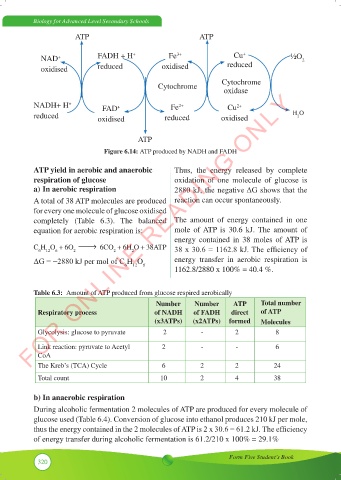Page 327 - Biology_F5
P. 327
Biology for Advanced Level Secondary Schools
ATP ATP
+
+
NAD FADH + H Fe 3+ Cu ½O 2
+
oxidised reduced oxidised reduced
Cytochrome Cytochrome
oxidase
FOR ONLINE READING ONLY
NADH+ H + FAD Fe 2+ Cu 2+
+
reduced oxidised reduced oxidised H O
2
ATP
Figure 6.14: ATP produced by NADH and FADH
ATP yield in aerobic and anaerobic Thus, the energy released by complete
respiration of glucose oxidation of one molecule of glucose is
a) In aerobic respiration 2880 kJ, the negative ΔG shows that the
A total of 38 ATP molecules are produced reaction can occur spontaneously.
for every one molecule of glucose oxidised
completely (Table 6.3). The balanced The amount of energy contained in one
equation for aerobic respiration is: mole of ATP is 30.6 kJ. The amount of
energy contained in 38 moles of ATP is
C H O + 6O ⎯ →⎯ 6CO + 6H O + 38ATP 38 x 30.6 = 1162.8 kJ. The efficiency of
6 12 6 2 2 2
ΔG = −2880 kJ per mol of C H O energy transfer in aerobic respiration is
6 12 6
1162.8/2880 x 100% = 40.4 %.
Table 6.3: Amount of ATP produced from glucose respired aerobically
Number Number ATP Total number
Respiratory process of NADH of FADH direct of ATP
(x3ATPs) (x2ATPs) formed Molecules
Glycolysis: glucose to pyruvate 2 - 2 8
Link reaction: pyruvate to Acetyl 2 - - 6
CoA
The Kreb’s (TCA) Cycle 6 2 2 24
Total count 10 2 4 38
b) In anaerobic respiration
During alcoholic fermentation 2 molecules of ATP are produced for every molecule of
glucose used (Table 6.4). Conversion of glucose into ethanol produces 210 kJ per mole,
thus the energy contained in the 2 molecules of ATP is 2 x 30.6 = 61.2 kJ. The efficiency
of energy transfer during alcoholic fermentation is 61.2/210 x 100% = 29.1%
Form Five Student’s Book
320

